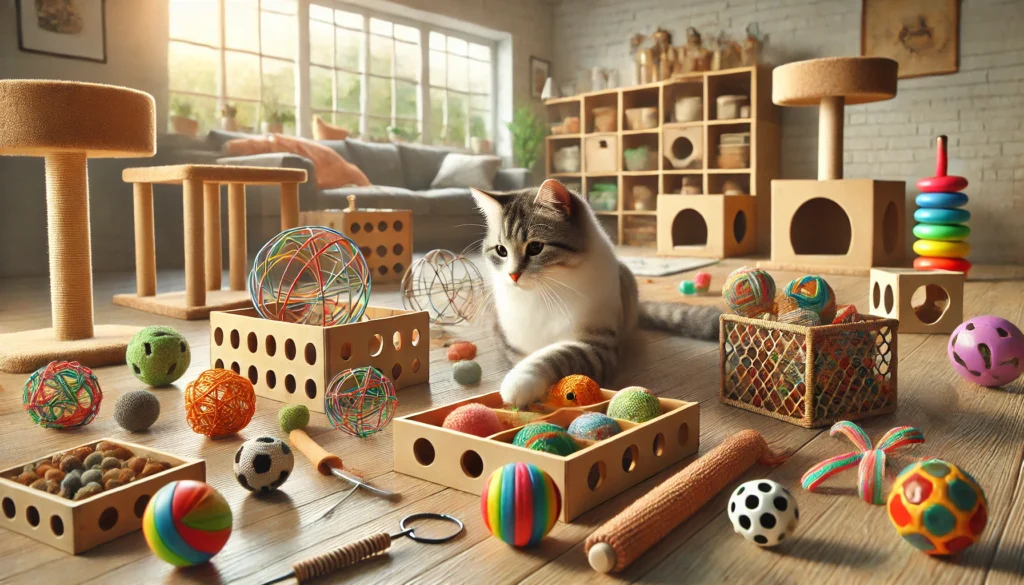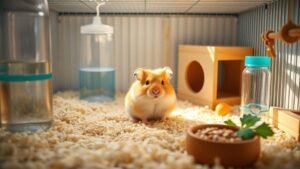Cats may seem independent, but they need mental and physical stimulation just as much as dogs — especially if they live strictly indoors. Without adequate enrichment, cats can develop boredom-related behaviors such as excessive meowing, scratching, overgrooming, or lethargy.
Toys are more than entertainment. They’re essential tools for promoting your cat’s health, natural instincts, and emotional balance. In this guide, you’ll discover the best types of indoor cat toys to keep your feline mentally engaged, plus how to use them effectively in daily routines.
Why Mental Stimulation Matters for Indoor Cats
Wild cats spend most of their day hunting, stalking, and solving problems to survive. Indoor cats, on the other hand, are often fed from a bowl and lack opportunities for challenge and engagement.
Mental stimulation through toys helps cats:
- Burn energy
- Reduce anxiety and stress
- Prevent destructive or obsessive behavior
- Improve sleep and appetite
- Strengthen the bond with their human companions
Enrichment toys provide both physical activity and cognitive workout — essential for long-term wellness.
Categories of Enriching Cat Toys
Different toys satisfy different feline instincts. A well-rounded toy selection should include:
1. Interactive Toys (With You)
These encourage play between you and your cat, reinforcing your bond.
Examples:
- Wand toys with feathers, ribbons, or plush mice
- Laser pointers (used safely and briefly)
- Fishing pole toys with retractable cords
Benefits:
- Simulates hunting
- Builds trust
- Offers real-time engagement and exercise
2. Solo Toys (Independent Play)
These keep your cat entertained when you’re away or busy.
Examples:
- Soft plush toys to bat and carry
- Crinkle balls or textured spinners
- Catnip or silvervine-infused toys
Benefits:
- Great for self-soothing
- Encourages solo exploration
- Ideal for shy or independent cats
3. Puzzle Toys and Food Dispensers
Turn feeding time into an interactive challenge.
Examples:
- Treat balls
- Slow feeders with hidden kibble
- DIY puzzles using cups, boxes, or egg cartons
Benefits:
- Encourages mental problem-solving
- Slows down fast eaters
- Prevents boredom-related eating
4. Electronic or Motion Toys
Mimic real prey movement and keep cats guessing.
Examples:
- Battery-powered toys that move unpredictably
- Ball circuits with moving tracks
- Robotic mice or automated feather spinners
Benefits:
- Stimulates curiosity
- Offers variety for energetic cats
- Can be scheduled while you’re out
5. DIY and Budget-Friendly Toys
Some of the best enrichment comes from household items.
Examples:
- Paper bags with the handles removed
- Cardboard boxes with cut-out holes
- Toilet paper tubes filled with kibble
- Ice cubes on tile floors for paw play
Benefits:
- Low-cost, creative stimulation
- Easily replaced
- Allows for rotation and experimentation
How to Introduce and Rotate Toys
Cats can become bored if toys are always available and never change.
- Introduce 2–3 toys at a time
- Rotate weekly to keep interest high
- Store unused toys in a “toy box” with catnip for scent refresh
- Observe which toys your cat prefers: chase, wrestle, chew, or carry
Rotating toys also keeps the play environment clean and manageable.
Creating Toy Zones in Your Home
Help your cat feel engaged by designing specific play areas.
Ideas:
- A mat near a window with wand toys and solo balls
- A quiet corner with puzzle feeders
- Under a chair or coffee table with tunnels or hideouts
- Vertical shelves with dangling or motion-activated toys
Cats enjoy both open play and hidden ambush spots. Providing both keeps them entertained and fulfilled.
Supervision and Safety
- Check for loose parts, small pieces, or damaged seams
- Avoid string or rubber bands unsupervised
- Don’t leave battery-operated toys on when you’re not home
- Remove worn-out toys before they become a hazard
Even “safe” toys can become dangerous if chewed or damaged over time.
Tips for Playtime Success
- Match play sessions to your cat’s energy level
- Use play before meals to simulate the “hunt-eat-sleep” cycle
- Keep sessions short and meaningful (5–10 minutes is enough)
- Let them “catch” the toy occasionally to build satisfaction
- Praise gently and offer a treat or cuddle afterward
Regular play builds confidence and trust — especially in anxious or newly adopted cats.
Best Toys for Different Cat Personalities
High-energy cats:
- Laser toys
- Automatic motion toys
- Tunnel chases
Shy or senior cats:
- Catnip kickers
- Soft plush mice
- Feather wands at slow speed
Food-motivated cats:
- Puzzle feeders
- Snuffle mats
- Kibble-stuffed toys
Kittens:
- Small balls
- Safe crinkle toys
- Light-up spinners
Matching toys to your cat’s play style increases engagement and satisfaction.
Toys Are More Than Just Fun
The right indoor toys provide your cat with essential outlets for movement, curiosity, and stress relief. They enrich your cat’s day, prevent unwanted behavior, and offer daily opportunities for interaction and joy.
Whether you’re tossing a mouse toy across the floor or watching your cat solve a puzzle feeder, you’re not just playing — you’re investing in their well-being.






